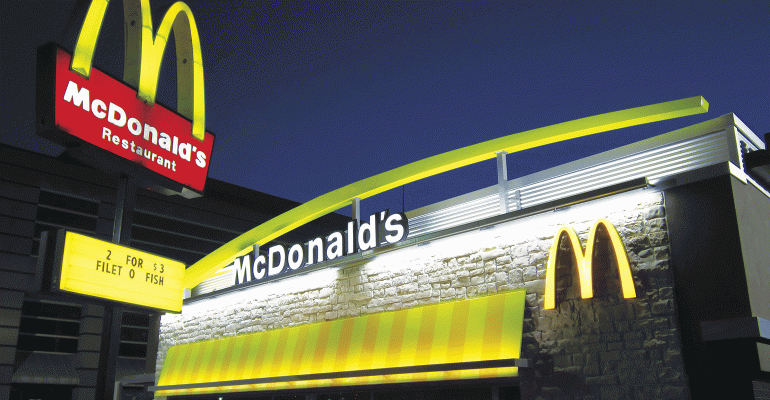McDonald’s Corp.’s 3.9 percent same-store sales growth in the second quarter wasn’t just good for the Oak Brook, Ill.-based company and its investors, it was good for the whole restaurant industry.
At least that’s the case in the minds of investors, who not only sent McDonald’s stock up 5 percent on the better-than-expected results, they sent restaurant industry stocks up, too.
The NRN Restaurant Index was up 2 percent on Tuesday.
McDonald’s results eased worries that the industry was in for a prolonged slump — even though executives with the burger giant, the world’s biggest restaurant company and the dominant chain in the U.S., said the company widened its gap with competitors.
The Oak Brook, Ill.-based burger chain’s 3.9-percent same-store sales growth outpaced other quick-service sandwich chains by 3.5 percent in the quarter.
And roughly half of McDonald’s same-store sales growth in the quarter came from higher customer counts, which are now up 1.8 percent so far in 2017. That means McDonald’s is luring more customers with its $1 drink promotion and its premium Signature Crafted Recipes sandwiches.
“It’s a market share fight,” CEO Steve Easterbrook said on the company’s second quarter earnings call Tuesday. “Everyone is working hard to up their game. The fact that we begun to open up a gap with QSR sandwich competitors gives us encouragement that we’re regaining some of the customers we’ve lost over a handful of years.”
“Our gain will result in pain being felt elsewhere,” he added. “Others will decide what they disclose.”
Stock in many of those competitors was hardly hurt by those comments. Stock in Burger King owner Restaurant Brands International Inc., Sonic Corp., The Wendy’s Co. and Jack in the Box Inc. all rose as of mid-afternoon Tuesday.
McDonald’s stock has been surging for much of the year. The stock at one point Tuesday hit a new record high, up 32 percent year to date and one of the strongest performances of any publicly traded restaurant stock.
Investors are enthused about the stock because the company has generated same-store sales growth, and now guest count growth, while some of its bigger long-term initiatives have yet to have an impact.
That includes Experience of the Future, which lets customers who come into the restaurants order via kiosk. Executives said that restaurants adding those kiosks generate same-store sales growth in the mid single digits.

McDonald’s plans to have those kiosks in 2,500 locations by the end of this year, and plans to pick up the pace of development in 2018.
“We see a pickup almost immediately in the first four to six weeks,” Easterbrook said. Yet he noted that the effort could yield “years of growth.”
And Easterbrook referenced the performance of the company’s more established International Lead Markets, which includes many markets in Europe as well as Australia. Same-store sales increased 6.3 percent in those markets, many of which have had kiosks for years.
Another effort is delivery. McDonald’s started out the year testing delivery in just a few locations in Florida. Now about a quarter of the company’s 14,000 locations have delivery and the chain plans to continue to add more throughout the year through UberEats.
Delivery orders are typically nearly twice as large as a typical order, and 60 percent come during the evening and late night when McDonald’s generates less business, generally.
Lucy Brady, senior vice president, corporate strategy and business development, said that more than 70 percent of delivery customers would not have come into the restaurant. “We believe now it’s highly incremental,” she said. “We’re tapping into a different use case.”
Mobile order and pay is another strategy the company hopes will generate sales. The capability is now available in 1,300 locations in the U.S. The company wants mobile order in all of its domestic restaurants by the end of the year.
Mobile order comes with higher average checks and curbside pickup can increase capacity at peak times, Easterbrook said.
The capability could help address one of the company’s concerns: Speed.
Easterbrook said that the company’s time of service “has gone backwards a little bit” in recent years even though customer satisfaction is up. Mobile ordering could ease congestion, as could curbside service. Executives believe kiosks will help, too.
Time of service improvements will be important as McDonald’s plans to start serving quarter-pound burgers that are made to order with fresh beef at this time next year. That effort could put McDonald’s speed to the test.
“Technology will underpin our ability to shave seconds and ultimately tens of seconds off speed of service,” he said.
Contact Jonathan Maze at [email protected]
Follow him on Twitter: @jonathanmaze




